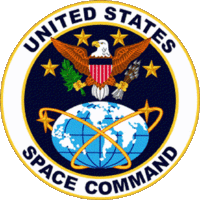United States Space Command
This article includes a list of general references, but it lacks sufficient corresponding inline citations. (July 2010) |
| United States Space Command | |
|---|---|
 U.S. Space Command emblem | |
| Active | 1985 - 2002 |
| Country | United States of America |
| Type | Unified Combatant Command |
| Garrison/HQ | Peterson AFB, Colorado |
The United States Space Command (USSPACECOM) was a Unified Combatant Command of the United States Department of Defense, created in 1985 to help institutionalize the use of outer space by the United States Armed Forces. The Commander in Chief of U.S. Space Command (CINCUSSPACECOM), with headquarters at Peterson Air Force Base, Colorado was also the Commander in Chief of the binational U.S.-Canadian North American Aerospace Defense Command (CINCNORAD), and for the majority of time during USSPACECOM’s existence also the Commander of the U.S. Air Force major command Air Force Space Command. Military space operations coordinated by USSPACECOM proved to be very valuable for the U.S.-led coalition in the 1991 Persian Gulf War.
The U.S. military has relied on satellite communications, intelligence, navigation, missile warning and weather systems in areas of conflict since at least the early 1990s, including the Balkans, Southwest Asia and Afghanistan. Space systems have since then been considered as indispensable providers of tactical information to U.S. forces.
As part of the ongoing initiative to transform the U.S. military, on June 26, 2002, Secretary of Defense Donald Rumsfeld announced that U.S. Space Command would merge with USSTRATCOM. The Unified Command Plan directed that Unified Combatant Commands be capped at ten, and with the formation of the new United States Northern Command, one would have to be deactivated in order to maintain that level. Thus the USSPACECOM merger into an expanded USSTRATCOM, which would retain the U.S. Strategic Command name and would be headquartered at Offutt Air Force Base. The merger was intended to improve combat effectiveness and speeds up information collection and assessment needed for strategic decision-making.
Within STRATCOM, responsibilities for space were first held by the Joint Functional Component Command for Space and Global Strike until July 2006 when the command was divided. Space operations are now overseen by the Joint Functional Component Command for Space.
Commanders
| Name | Photo | Start | End | Notable offices held before or after | |
|---|---|---|---|---|---|
| 1 | General Robert T. Herres, USAF |  |
1985 | 1987 | 1st Vice Chairman of the Joint Chiefs of Staff (1987–1990) |
| 2 | General John L. Piotrowski, USAF |  |
1987 | 1990 | 22nd Vice Chief of Staff of the Air Force (1985–1987) |
| 3 | General Donald J. Kutyna, USAF |  |
1990 | 1992 | Member of the Rogers Commission (1986–1988) |
| 4 | General Charles A. "Chuck" Horner, USAF |  |
June, 1992 | September, 1994 | Commander, 9th Air Force, and Commander, U.S. Central Command Air Forces (1987–1992), he led U.S. and allied air operations for Operations Desert Shield and Desert Storm. |
| 5 | General Joseph W. Ashy, USAF |  |
September, 1994 | August, 1996 | |
| 6 | General Howell M. Estes III, USAF |  |
August, 1996 | August 14, 1998 | |
| 7 | General Richard B. Myers, USAF |  |
August 14, 1998 | February 22, 2000 | 5th Vice Chairman of the Joint Chiefs of Staff (2000–2001) 15th Chairman of the Joint Chiefs of Staff (2001–2005) |
| 8 | General Ralph E. "Ed" Eberhart, USAF |  |
February 22, 2000 | October 1, 2002 | 27th Vice Chief of Staff of the Air Force (1997–1999) Commander, United States Northern Command (2002–2005) |
